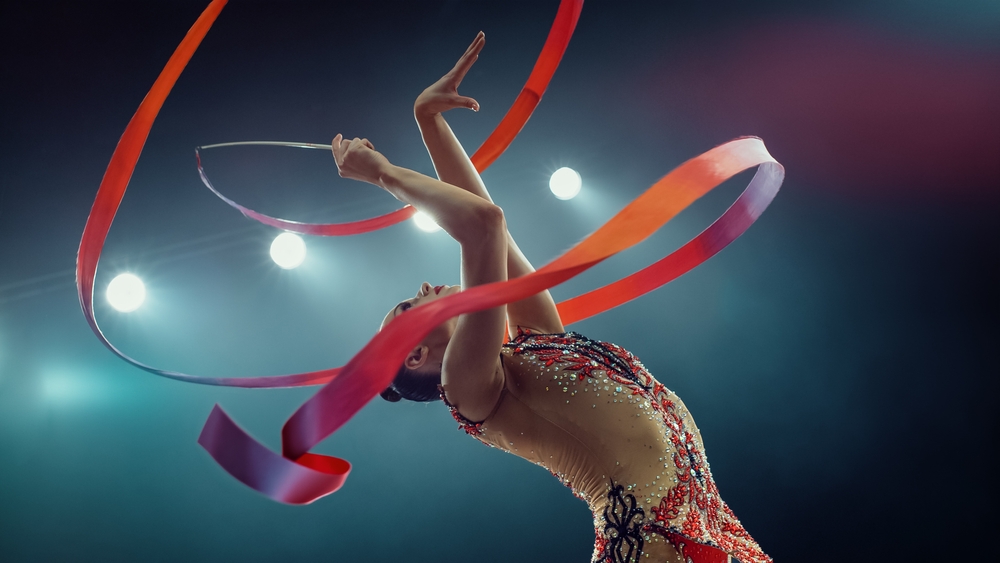Rhythmic Gymnastics: Where Sport Meets Art
In the vibrant world of competitive sports, rhythmic gymnastics stands out as a mesmerizing blend of athleticism and artistry. This unique discipline pushes the boundaries of human flexibility, coordination, and creativity, captivating audiences with its graceful performances. As athletes manipulate hoops, balls, ribbons, and clubs with seemingly effortless precision, they tell stories through movement, challenging our perception of what the human body can achieve.

The International Gymnastics Federation (FIG) recognized rhythmic gymnastics as an official discipline in 1961, paving the way for its inclusion in major international competitions. The sport made its Olympic debut as an individual event at the 1984 Los Angeles Games, with group competitions added in 1996 in Atlanta. Since then, rhythmic gymnastics has continued to grow in popularity and complexity, attracting athletes from around the world.
The Fundamentals of Rhythmic Gymnastics
At its core, rhythmic gymnastics is a sport that combines elements of ballet, gymnastics, dance, and apparatus manipulation. Athletes, known as gymnasts, perform routines that showcase their flexibility, balance, coordination, and artistic expression. These routines are set to music and typically last between 75 and 90 seconds for individual performances, and 2 minutes and 30 seconds for group routines.
The sport utilizes five different apparatus: rope, hoop, ball, clubs, and ribbon. Each apparatus requires specific skills and techniques:
-
Rope: Gymnasts perform jumps, swings, throws, and catches, often creating intricate patterns with the rope.
-
Hoop: This apparatus allows for rolls along the body, rotations, throws, and catches, often incorporating acrobatic elements.
-
Ball: Gymnasts demonstrate fluid movements, balancing the ball on different parts of their body and performing impressive throws and catches.
-
Clubs: These require precise handling, with gymnasts executing mills, small circles, throws, and catches in synchronization.
-
Ribbon: Perhaps the most visually striking, the ribbon is used to create beautiful patterns in the air, with gymnasts performing spirals, snakes, and throws.
The Technical and Artistic Components
Rhythmic gymnastics routines are evaluated based on both technical difficulty and artistic impression. The technical component assesses the gymnast’s ability to perform complex movements with the apparatus, including throws, catches, and manipulations. Judges look for precision, amplitude, and the seamless integration of body movements with apparatus handling.
The artistic component evaluates the overall composition and performance of the routine. This includes the choreography, musical interpretation, and the gymnast’s ability to convey emotion and tell a story through movement. Judges consider factors such as expressiveness, fluidity of movement, and the overall aesthetic appeal of the routine.
The combination of these elements makes rhythmic gymnastics a uniquely challenging sport. Athletes must possess not only exceptional physical abilities but also a keen sense of musicality and artistic expression. This blend of skills sets rhythmic gymnastics apart from many other competitive sports and contributes to its captivating nature.
Training and Physical Demands
The path to becoming an elite rhythmic gymnast is demanding and requires years of dedicated training. Most gymnasts begin their training at a very young age, often starting as early as 4 or 5 years old. The sport demands extreme flexibility, strength, and coordination, all of which must be developed through consistent practice.
A typical training regimen for a competitive rhythmic gymnast includes:
-
Flexibility training: Daily stretching routines to maintain and improve flexibility in all parts of the body, particularly the back, hips, and shoulders.
-
Ballet and dance classes: These help develop grace, posture, and artistic expression.
-
Strength and conditioning: Core strength, upper body strength, and overall muscular endurance are crucial for executing complex movements and maintaining control of the apparatus.
-
Apparatus handling: Hours of practice with each apparatus to perfect throws, catches, and manipulations.
-
Choreography and routine practice: Working with coaches to develop and refine competitive routines.
-
Mental preparation: Visualization techniques and psychological training to handle the pressures of competition.
The physical demands of rhythmic gymnastics are intense. Gymnasts must maintain a high level of flexibility while also developing the strength needed to control their bodies and the apparatus. This combination of flexibility and strength is particularly challenging and sets rhythmic gymnastics apart from many other sports.
The Global Landscape of Rhythmic Gymnastics
While rhythmic gymnastics has gained popularity worldwide, certain countries have historically dominated the sport. Russia, Belarus, Ukraine, and Bulgaria have been particularly successful, producing many Olympic and World Championship medalists. However, in recent years, countries like Italy, Israel, and Azerbaijan have also emerged as strong competitors on the international stage.
The global spread of rhythmic gymnastics has led to diverse styles and interpretations of the sport. Eastern European countries often emphasize extreme flexibility and technical precision, while gymnasts from other regions may focus more on artistic expression and innovative choreography. This diversity has contributed to the evolution of the sport, pushing the boundaries of what is possible in terms of both technical difficulty and artistic creativity.
International competitions in rhythmic gymnastics include:
-
Olympic Games: The pinnacle of the sport, featuring individual all-around and group competitions.
-
World Championships: Held annually (except in Olympic years), including individual apparatus finals in addition to all-around and group events.
-
European Championships: A major continental competition showcasing Europe’s top gymnasts.
-
Grand Prix and World Cup series: Regular international competitions that allow gymnasts to compete throughout the year.
These competitions not only showcase the world’s best gymnasts but also serve as platforms for the sport’s continued evolution, as athletes and coaches push the boundaries of difficulty and artistry.
The Role of Music and Choreography
One of the most distinctive aspects of rhythmic gymnastics is its use of music and choreography. Unlike many other sports where music might be incidental or absent, in rhythmic gymnastics, it is an integral part of the performance. The choice of music and the choreography that accompanies it are crucial elements that can make or break a routine.
Gymnasts and their coaches carefully select music that complements their strengths and allows for a dynamic and engaging routine. The music can range from classical pieces to contemporary pop songs, and even include vocals in senior-level competitions. The key is to choose a piece that allows the gymnast to showcase both technical skills and artistic expression.
Choreography in rhythmic gymnastics is a complex process that involves:
-
Interpreting the music: Movements must be synchronized with the rhythm and mood of the chosen piece.
-
Incorporating required elements: Routines must include specific body difficulties and apparatus handling techniques as mandated by the Code of Points.
-
Developing a theme or story: Many routines aim to convey a narrative or emotional journey through movement and expression.
-
Maximizing use of the performance space: Gymnasts must cover the entire floor area while executing their routines.
-
Highlighting the gymnast’s strengths: Choreography is often tailored to showcase the individual athlete’s best skills and unique style.
The seamless integration of music, movement, and apparatus manipulation is what gives rhythmic gymnastics its captivating quality. When executed at the highest level, a routine can transcend sport to become a true artistic performance.
Judging and Scoring
The judging system in rhythmic gymnastics is complex and has evolved over the years to better reflect the multifaceted nature of the sport. Currently, routines are evaluated by two panels of judges:
-
Difficulty (D) Panel: This panel assesses the technical content of the routine, including the difficulty of body movements and apparatus handling. They award points based on the successful execution of specific elements.
-
Execution and Artistry (E) Panel: This panel evaluates the quality of performance, including technical execution, artistic components, and any errors or faults during the routine. They start from a perfect 10 and deduct points for mistakes.
The final score is a combination of these two components, with the potential for very high scores in the high teens or even low 20s for exceptional performances at the elite level.
Judging in rhythmic gymnastics requires extensive knowledge of the sport’s technical requirements and artistic standards. Judges undergo rigorous training and must be certified by the FIG to officiate at international competitions. Despite this, judging can sometimes be controversial due to the subjective nature of evaluating artistic impression.
Challenges and Controversies
Like many aesthetic sports, rhythmic gymnastics has faced its share of challenges and controversies:
-
Body image issues: The sport’s emphasis on grace and flexibility has sometimes led to unhealthy body ideals and eating disorders among athletes. Efforts are being made to promote healthier attitudes and practices.
-
Age controversies: There have been instances of age falsification, with some countries allegedly fielding underage gymnasts in senior competitions. The FIG has implemented stricter age verification processes in response.
-
Judging disputes: The subjective nature of scoring, particularly in the artistic component, has led to occasional disputes and accusations of bias.
-
Dominance by certain countries: The historical dominance of Eastern European countries has raised questions about the accessibility and development of the sport in other regions.
-
Equipment standardization: Ensuring fairness in apparatus specifications while allowing for innovation has been an ongoing challenge for the sport’s governing bodies.
Despite these challenges, the rhythmic gymnastics community continues to work towards creating a more inclusive, fair, and healthy competitive environment.
The Future of Rhythmic Gymnastics
As rhythmic gymnastics moves into the future, several trends and developments are shaping its evolution:
-
Increasing difficulty: With each Olympic cycle, the level of difficulty in both body movements and apparatus handling continues to rise, pushing the boundaries of human capability.
-
Technological integration: The use of technology in training, performance analysis, and even in the design of apparatus is becoming more prevalent.
-
Broader global participation: Efforts are being made to promote the sport in regions where it has been less prominent, aiming for more diverse international competition.
-
Male participation: While currently an overwhelmingly female sport, there is growing interest in developing men’s rhythmic gymnastics, with some countries already holding national competitions for male gymnasts.
-
Cross-disciplinary influence: The sport continues to draw inspiration from other disciplines such as contemporary dance, circus arts, and even martial arts, leading to innovative new elements and styles.
-
Focus on athlete well-being: There is an increasing emphasis on the physical and mental health of gymnasts, with more attention being paid to sustainable training methods and career longevity.
As rhythmic gymnastics continues to evolve, it remains a unique and captivating sport that challenges our perceptions of human physical and artistic capabilities. Its blend of athleticism, grace, and creativity ensures its place as one of the most visually stunning and technically demanding sports in the world.
Conclusion
Rhythmic gymnastics stands at the intersection of sport and art, demanding a rare combination of physical prowess, artistic sensitivity, and mental fortitude from its practitioners. From its humble beginnings in the early 20th century to its current status as an Olympic sport, rhythmic gymnastics has continually pushed the boundaries of human performance and artistic expression.
The sport’s unique blend of flexibility, strength, coordination, and creativity sets it apart in the world of competitive athletics. As gymnasts manipulate their apparatus with seemingly impossible precision and grace, they create performances that are as much about storytelling and emotion as they are about physical skill.
Despite facing challenges related to judging subjectivity, body image concerns, and the need for greater global representation, rhythmic gymnastics continues to evolve and captivate audiences worldwide. The ongoing push for increased difficulty, coupled with innovations in choreography and musical interpretation, ensures that the sport remains dynamic and exciting.
As we look to the future, rhythmic gymnastics is poised to continue its growth and development. With efforts to increase global participation, explore new technological integrations, and potentially expand into men’s competition, the sport is embracing change while maintaining its core essence.
Ultimately, rhythmic gymnastics reminds us of the incredible potential of the human body and spirit. It challenges athletes to be not just supreme physical specimens, but also artists, storytellers, and innovators. For spectators, it offers a unique and mesmerizing spectacle that blurs the lines between sport and art, leaving us in awe of what dedicated training, creativity, and passion can achieve.
As the sport moves forward, it will undoubtedly continue to inspire, challenge, and amaze, cementing its place as one of the most beautiful and demanding disciplines in the world of sports. Whether you’re a seasoned fan or a newcomer to the world of rhythmic gymnastics, there’s no denying the power and beauty of this extraordinary sport that truly embodies the fusion of athletic excellence and artistic expression.





